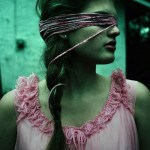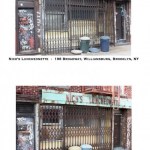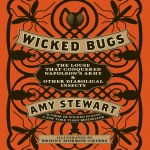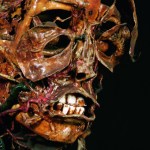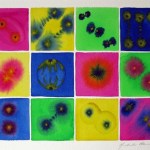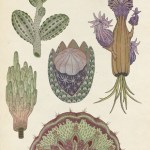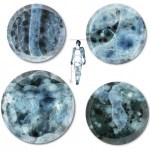
The New York Times did a special Sunday supplement on graduate programs. The editorial graphics they commissioned have much truth to them, grasshopper.
Untitled, from "The Others"Jordan Tiberio
My favorite thing about the internet is serendipity. Click here, click there, and the next thing you know you're scrolling down the gallery of an 18-year-old photographer whose artistic sensibility seems equal parts 1970s fashion magazine, pre-Raphaelite fairy tale, and Sigur Ros music video. Lovely young women are hardly an original topic, but Tiberio's work seems to catch a disquieted, ambivalent undertone to the beauty. Is it ambivalence about the artifice of fashion, about aging, about one's own body and sexuality? I have no idea, but I'm…
Note: except for the fact that it was in Washington DC, I don't remember where I took this photo. . . :)
Nick's LuncheonetteRandy Hage
Via the eye-candy blog How to Be a Retronaut (thanks Miles for first sending me a link there), the painstakingly accurate miniature Manhattan streetscapes of LA artist Randy Hage are half-toy, half-historical document - a wonder cabinet of urban curiosities.
Hage's overarching goal is to preserve rapidly disappearing streetscapes. As he told Jeremiah Moss at Vanishing New York,
I remember one instance in particular that prompted me to seriously focus on this project. I was on my way to revisit a Brooklyn donut shop that I had photographed a year earlier. I…
The most beautiful experience we can have is the mysterious. It is the fundamental emotion which stands at the cradle of true art and true science. Whoever does not know it can no longer wonder, no longer marvel, is as good as dead, and his eyes are dimmed.
Albert EinsteinIdeas and Opinions, New York: Crown, 1954.
(quoted in Lawrence Weschler's Mr. Wilson's Cabinet of Wonder: Pronged Ants, Horned Humans, Mice on Toast, and Other Marvels of Jurassic Technology, New York: Random House, 1995.)
From the Smithsonian, a short video about using technology to virtually reassemble ancient art from fragments long carried away and dispersed:
Majestic sixth-century Chinese Buddhist sculpture is combined with 3-D imaging technology in this exploration of one of the most important groups of Buddhist devotional sites in early medieval China. Carved into the mountains of northern China, the Buddhist cave temples of Xiangtangshan were the crowning cultural achievement of the Northern Qi dynasty (550-77 CE). Once home to a magnificent array of sculptures--monumental Buddhas, divine attendant…
If this luminous, high-definition, time-lapse film of Arctic skies and seas by Norwegian photographer TSO (Terje Sorgjerd) doesn't vaporize your stress in under three minutes, I don't know what will. Be sure to click the video controls to view full-screen - this one is worth it.
Via Andrew Sullivan.
Amy Stewart's new book Wicked Bugs: The Louse That Conquered Napoleon's Army & Other Diabolical Insects takes a fairly trivial concept - a collection of historical anecdotes and icky factoids about dangerous insects - and executes it remarkably well. The book is well-written and has a non-cloying sense of humor ("she's just not that into you," begins the section relating how female praying mantids eat the males). Briony Morrow-Cribbs lends her insect illustrations (see a NYTimes slideshow of her ink illustrations here), and Anne Winslow's design plays off the concept of a vintage…
This 1967 IBM propaganda film, "Paperwork Explosion," couples an eerily deadpan refrain of "more time on paperwork," with a creepy pseudo-country neighbor* urging us to embrace Progress.
The film's frenetic soundtrack and abrupt transitions embody the familiar hysterical nervousness of an increasingly automated era, while striving the whole time to convince us that technology will relieve the pressures of the modern workplace, allowing us to "think" instead of "work". Looking back, of course, it's clear that technology instead cranked the pressure up. If writers like Nicholas Carr are to be…
. . . they could have. Or pretty darn close, at least - they just needed to visit one of the many European cabinets of anatomical curiosities, to see the work of anatomists like Honore Fragonard.
Fragonard's eighteenth-century ecorches were the clear precursors to Gunther von Hagens' "Body Worlds" exhibits: preserved, injected, partially dissected bodies in lifelike, dramatic poses, with ragged strips of muscle draped like primitive clothing over exposed vessels and nerves. The effect is eerie - like a Vesalius illustration sprung to (half-)life:
Man with a Mandible
Several of Fragonard's…
One of the much-hyped benefits of social networking is that it provides a way to get personalized recommendations about businesses from a wider network. If I want to tell the world that the coffee place in my neighborhood has the best cappuccino this side of Seattle, I can do that (and it does)! That's what Yelp is for - right?
Well, not quite. I realized a while ago that my reviews don't show up on Yelp anymore. They've been "filtered" from the site, like thousands of other users' reviews. Yelp won't explain why (they say if they did explain the algorithm, it would allow merchants to game…
Via Alexis Madrigal's Mississippi explainer at the Atlantic, this beautiful map of the Mississippi's historic meanderings is like a carelessly draped cluster of silk ribbons. Madrigal says,
If the Mississippi were allowed to do what it wanted, what is now the Atchafalaya River would become the new ending of the Mississippi. Again, in a purely natural world, that would be a six of one, half dozen of the other situation. But now human systems depend on the Mississippi remaining roughly as it was in 1900 when we started to build massive amounts of infrastructure.
As you can see, the river is a…
Cell Division IV
Michele Banks
DC area artist Michele Banks has donated one of her cell division watercolors to raise funds for art outreach. Check out the online auction - the painting is matted and framed and currently going for only $52.
Michele is not a biologist, but she's been on a sci-art kick for a while, inspired by the fortuitous resemblance of watercolor patterns to cellular structures. To see more of her work, visit her etsy shop, artologica.
A CSPO webcast entitled "New Tools for Science Policy" asks an interesting, if somewhat odd, question about science and art: "Can art and religion serve as methods for governing emerging science and technology?"
More details:
Tuesday, May 24, 2011, 5:30 p.m. EDT (webcast will be here)
Participants:
Dr. Greg Graffin, Recent author of Anarchy Evolution, professor of evolutionary biology at Cornell University, and lead singer of Bad Religion, one of the most successful punk rock bands in the world.
Steve Olson, Co-author with Dr. Graffin of Anarchy Evolution, freelance writer, and former Special…
minouette of magpie & whiskeyjack has posted an interesting meditation on the resemblances between Katie Scott's whimsical faux-botanical/biological atlas pages (above), the illustrations of Ernst Haeckel (whose portrait minouette just finished), and the Codex Seraphinianous. It's a harmonious grouping of artistic influences - check it out.
The making of an hourglass:
The Hourglass from Ikepod on Vimeo.
"Director Philip Andelman traveled to Basel, Switzerland, to document the designer's modern take of the classic hourglass inside the Glaskeller factory. Each hand made hourglass comprises highly durable borosilicate glass and millions of stainless steel nanoballs, and is available in a 10 or 60 minute timer."
Music by Philip Glass ("Opening").
Via Braniac.
Former Scibling Sheril Kirshenbaum, late of the Intersection, has moved to a new blog: Convergence. Let's be honest: most of us are about intersections, convergences, confluences and whatnot; I've often described BioE as "the intersection of art & science." But Sheril's kicking the metaphor up a notch:
Convergence is a forum to explore all sorts of topics, but the primary focus will be the interdisciplinary nature of understanding our world. For example, if we aspire to protect biodiversity, we must address social issues. Boosting fisheries requires economics. Tackling our tremendous…
Animated Anatomies, a new show at the Perkins Library at Duke University, explores the tradition of fold-out or pop-up paper anatomical diagrams:
Animated Anatomies explores the visually stunning and technically complex genre of printed texts and illustrations known as anatomical flap books. These publications invite the viewer to participate in virtual autopsies, through the process of unfolding their movable leaves, simulating the act of human dissection. This exhibit traces the flap book genre beginning with early examples from the sixteenth century, to the colorful "golden age" of…
. . . let the table settings do the talking (and the grossing out) for you! These Consumption Dinnerware plates by Leah Piepgras "are a map of the digestive tract, from mouth to anus:"
I'm trying to decide if these plates have a future as a diet aid.* Visualizing the eventual chyme-ish fate of a bolus of taco salad might just induce me to eat less. . . on the other hand, the dreamy blue watercolor palette makes me think of snowflakes, not chyme and gall. And I think I've done too many dissections for a medical illustration to have much of an effect.
Via the design blog CollabCubed.
*you…
They're doing exactly what we always complain our brightest students don't do: eschewing the easy bucks of Wall Street, consulting or corporate law to pursue their ideals and be of service to society. Academia may once have been a cushy gig, but now we're talking about highly talented young people who are willing to spend their 20s living on subsistence wages when they could be getting rich (and their friends are getting rich), simply because they believe in knowledge, ideas, inquiry; in teaching, in following their passion. To leave more than half of them holding the bag at the end of it all…
